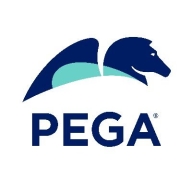

Pega Platform and PagerDuty Operations Cloud compete in the business operations and incident management sector. Pega Platform has the upper hand due to its comprehensive case and BPM management capabilities, which enhance operational efficiency.
Features: Pega Platform excels in rapid deployment, case management, and integration capabilities. It offers scalability for complex enterprise requirements and a no-code environment for swift prototyping and changes. Users value its comprehensive suite for BPM management. PagerDuty Operations Cloud is valued for its robust incident management and alerting features, including automatic escalation and comprehensive notification options ideal for managing on-call rotations and ensuring incident response.
Room for Improvement: Pega Platform users encounter challenges with the UI and demand better integration capabilities. Licensing complexity and pricing are a concern, alongside requests for enhanced machine learning and out-of-box solutions. PagerDuty users seek improved integration with external systems, better analytics, and more customization options for incident management. The cost of using PagerDuty is also a concern for some.
Ease of Deployment and Customer Service: Pega Platform offers on-premises and cloud deployment, but users experience mixed technical support, sometimes described as slow. PagerDuty, primarily cloud-based, is considered easy to deploy in cloud environments. Both platforms offer robust support, but users report varied experiences with response times and problem resolution effectiveness.
Pricing and ROI: Pega Platform's pricing is high and can be a barrier for SMEs, but its features deliver strong ROI for large enterprises. It offers varied licensing models, including per-user and per-case options. PagerDuty has straightforward pricing with scalable plans based on user needs. Despite some considering it pricey, the ROI is justified by its effective incident management and flexible pricing plans.
The technical support from Pega is very low, rating a one or two out of ten.
I never needed support from the platform standpoint, but if additional features are required, we have regular meetings with the product team for feedback.
Pega's technical support team is very helpful.
The product was highly scalable, with no limits on the number of applications or event routing rules.
Currently, big banking providers and insurance providers, even the members for healthcare payers, are using more than millions of operations on a daily or weekly basis.
It would be useful to have a way to define all configurations in code that is similar to how Terraform operates.
Pega introduced Constellation, which allows a user to build a more engaging visual experience.
For customer interactions, while the Pega Platform's AI-based decisioning and predictive analytics are great, the Process AI is not very popular yet, as it works on process data rather than customer data.
My learning curve in robotics has been challenging.
From a licensing perspective, it is higher than the competition.
The pricing is expensive, and this is an issue.
Pega is priced higher than open-source options like Flowable but is suitable for large-scale industries like banking and insurance.
It integrates with multiple applications and is highly customizable, with policies, escalation procedures, and an event routing tool that ensures contacting the right person.
Pega Platform is excellent for enterprise-level solutions with integrations to entire systems, including case management, service orchestration, CRM, decision-making capabilities, digital process automation, and AI-driven functionalities.
Management capabilities such as dashboards.
| Product | Market Share (%) |
|---|---|
| Pega Platform | 6.2% |
| PagerDuty Operations Cloud | 0.2% |
| Other | 93.6% |


| Company Size | Count |
|---|---|
| Small Business | 12 |
| Midsize Enterprise | 11 |
| Large Enterprise | 19 |
| Company Size | Count |
|---|---|
| Small Business | 9 |
| Midsize Enterprise | 15 |
| Large Enterprise | 68 |
The PagerDuty Operations Cloud is the platform for mission-critical, time-critical operations work in the modern enterprise. Through the power of AI and automation, it detects and diagnoses disruptive events, mobilizes the right team members to respond, and streamlines infrastructure and workflows across your digital operations. The Operations Cloud is essential infrastructure for revolutionizing digital operations to compete and win as a modern digital business.
PagerDuty Features
PagerDuty has many valuable key features. Some of the most useful ones include:
PagerDuty Benefits
There are many benefits to implementing PagerDuty. Some of the biggest advantages the solution offers include:
Reviews from Real Users
Below are some reviews and helpful feedback written by PeerSpot users currently using the PagerDuty solution.
Brandon J., Director of engineering at a wellness & fitness company, says, "The SMS pages and the mobile application are pretty much the top two features."
PeerSpot reviewer Pramodh M., DevSecOps Consultant at a tech services company, comments, “The inbound integrations that PagerDuty provides with most of the DevOps tools are valuable. There is a flexible and easy way of integrating with monitoring tools. It allows us to configure the integration with APIs and plugins as well.”
Syed Mohammad A., Vice President - Operations and Client Services at a financial services firm, mentions, "PagerDuty let us set up rosters based on our shifts. We could assign a hierarchy for how the calls should be escalated and the number of times the call will be transferred between people before it is answered. It makes it easy to access an agent via mobile phone."
A Principal Architect at an energy/utilities company states, “The most important feature that is used is call scheduling. We are also able to actually call IT folks in the case of an emergency.”
Pega Platform facilitates business process management, case management, and workflow automation for industries like banking, insurance, and healthcare. It supports digital transformation and customer service enhancements with its low-code capabilities and seamless integrations.
Pega Platform enables users to create efficient systems for case management, financial operations, and digital transformations. It provides tools for client onboarding, quoting, claims processing, customer experience improvements, and content management. Pega's low-code approach allows for the automation of complex processes, making it suitable for enterprises looking for adaptability and rapid deployment. While it offers strong real-time analytics and decision automation, users acknowledge challenges in user interface, integration, and performance aspects. High costs and a learning curve need attention, and enhancements in AI features and cloud services are desired.
What are the key features of Pega Platform?In banking, Pega Platform automates loan processing, accelerates customer onboarding, and manages compliance. Insurance companies benefit from streamlined claims processing and policy management. Healthcare sectors use the platform for patient engagement and care coordination, enabling organizations to adapt quickly to changing industry requirements.
We monitor all Process Automation reviews to prevent fraudulent reviews and keep review quality high. We do not post reviews by company employees or direct competitors. We validate each review for authenticity via cross-reference with LinkedIn, and personal follow-up with the reviewer when necessary.